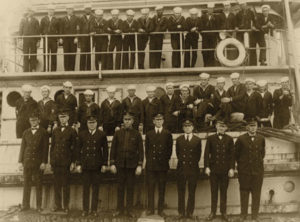 On March 23, 2016, NOAA and the U.S. Navy announced the discovery of the USS Conestoga (AT 54) in the Greater Farallones National Marine Sanctuary off San Francisco, 95 years after the Navy seagoing fleet tugboat disappeared with 56 officers and sailors aboard. The discovery solves one of the top maritime mysteries in U.S. Navy history.
On March 23, 2016, NOAA and the U.S. Navy announced the discovery of the USS Conestoga (AT 54) in the Greater Farallones National Marine Sanctuary off San Francisco, 95 years after the Navy seagoing fleet tugboat disappeared with 56 officers and sailors aboard. The discovery solves one of the top maritime mysteries in U.S. Navy history.
“After nearly a century of ambiguity and a profound sense of loss, the Conestoga’s disappearance no longer is a mystery,” said Manson Brown, assistant secretary of commerce for environmental observation and prediction and deputy NOAA administrator. “We hope that this discovery brings the families of its lost crew some measure of closure and we look forward to working with the Navy to protect this historic shipwreck and honor the crew who paid the ultimate price for their service to the country.”
On March 25, 1921, Conestoga departed the Golden Gate en route to Tutuila, American Samoa via Pearl Harbor, Hawaii. When Conestoga failed to reach Hawaii by its anticipated arrival date the Navy mounted a massive air and sea search around the Hawaiian Islands, the tug’s destination. Nearly two months later, on May 17, a merchant vessel found a battered lifeboat with the letter “C” on its bow off the Mexican coast leading to a search there.
For months, the ship’s mysterious disappearance gripped newspapers across the country. Unable to locate the ship or wreckage, the Navy declared Conestoga and its crew lost on June 30, 1921. This was the last U.S. Navy ship to be lost without a trace in peacetime.
In 2009, the NOAA Office of Coast Survey, as part of a hydrographic survey near the Farallon Islands off San Francisco, documented a probable, uncharted shipwreck. In September 2014, NOAA launched a two-year investigation co-directed by James Delgado and Robert Schwemmer, West Coast regional maritime heritage coordinator for NOAA’s Office of National Marine Sanctuaries, to document historic shipwrecks in the Greater Farallones sanctuary and nearby Golden Gate National Recreation Area. In October 2015, NOAA confirmed the identification and location of Conestoga during a mission that included an archaeologist from the Naval History and Heritage Command, as well as several senior Navy officers.
“Thanks to modern science and to cooperation between agencies, the fate of Conestoga is no longer a mystery,” said Assistant Secretary of the Navy for Energy, Installations and Environment Dennis V. McGinn. “In remembering the loss of the Conestoga, we pay tribute to her crew and their families, and remember that, even in peacetime, the sea is an unforgiving environment.”
During ROV dives, NOAA confirmed a number of features consistent with the description and plans of Conestoga published in 1904 including the size of the wreck; the four-bladed, 12-foot 3-inch diameter propeller; the steam engine and boilers; the number and location of portholes, mooring bitts, and ventilator locations; a large steam towing winch with twisted wire on the drum; two porcelain marine heads; and a single, 3-inch, 50-caliber gun that was mounted on the main deck in front of the pilot house.
No human remains were observed during the dives but Conestoga is protected under the National Marine Sanctuaries Act and the Sunken Military Craft Act of 2004, which prohibits unauthorized disturbance of sunken military vessels or planes owned by the U.S. government, as well as foreign sunken military craft that lie within U.S. waters.
Source: sanctuaries.noaa.gov
To see sonar images, historical photos and other materials, visit sanctuaries.noaa.gov/news/press/conestoga.









